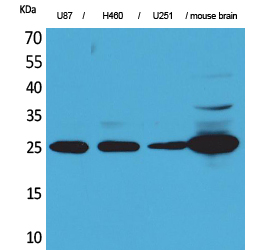
主要信息
Target
PGP9.5
Host Species
Mouse
Reactivity
Human, Mouse, Rat
Applications
IHC, IF, ELISA
MW
25kD (Calculated)
25kD (Observed)
Conjugate/Modification
Unmodified
货号: YM6209
规格
价格
货期
数量
200μL
¥3,780.00
现货
0
100μL
¥2,300.00
现货
0
40μL
¥960.00
现货
0
加入购物车


已收藏


收藏
详细信息
推荐稀释比
IHC 1:200-400; ELISA 1:500-5000; IF 1:50-200
组成
PBS, 50% glycerol, 0.05% Proclin 300, 0.05%BSA
特异性
The antibody can specifically recognize human PGP 9.5 protein.
纯化工艺
The antibody was affinity-purified from ascites by affinity-chromatography using specific immunogen.
储存
-15°C to -25°C/1 year(Do not lower than -25°C)
理论分子量
25kD
实测条带
25kD
修饰
Unmodified
克隆性
Monoclonal
克隆号
ABT-PGP9.5
同种型
IgG1,Kappa
相关产品
抗原&靶点信息
免疫原:
Synthesized peptide derived from human PGP 9.5 AA range: 100-223
展开内容
特异性:
The antibody can specifically recognize human PGP 9.5 protein.
展开内容
基因名称:
UCHL1
展开内容
蛋白名称:
Ubiquitin carboxyl-terminal hydrolase isozyme L1 (UCH-L1) (Neuron cytoplasmic protein 9.5) (PGP 9.5) (PGP9.5) (Ubiquitin thioesterase L1)
展开内容
背景:
The protein encoded by this gene belongs to the peptidase C12 family. This enzyme is a thiol protease that hydrolyzes a peptide bond at the C-terminal glycine of ubiquitin. This gene is specifically expressed in the neurons and in cells of the diffuse neuroendocrine system. Mutations in this gene may be associated with Parkinson disease.[provided by RefSeq, Sep 2009],
展开内容
功能:
Catalytic activity:Thiol-dependent hydrolysis of ester, thioester, amide, peptide and isopeptide bonds formed by the C-terminal Gly of ubiquitin (a 76-residue protein attached to proteins as an intracellular targeting signal).,Disease:Oxidation of Met-1, Met-6, Met-12, Met-124 and Met-179 to methionine sulfoxide, and oxidation of Cys-220 to cysteine sulfonic acid have been observed in brains from Alzheimer disease (AD) and Parkinson disease (PD) patients. In AD, UCHL1 was found to be associated with neurofibrillary tangles.,Function:Ubiquitin-protein hydrolase involved both in the processing of ubiquitin precursors and of ubiquitinated proteins. This enzyme is a thiol protease that recognizes and hydrolyzes a peptide bond at the C-terminal glycine of ubiquitin. Also binds to free monoubiquitin and may prevent its degradation in lysosomes. The homodimer may have ATP-independent ubiquitin ligase activity.,miscellaneous:In contrast to UCHL3, does not hydrolyze a peptide bond at the C-terminal glycine of NEDD8.,online information:Ubiquitin carboxy-terminal hydrolase L1 entry,PTM:O-glycosylated.,similarity:Belongs to the peptidase C12 family.,subunit:Homodimer. Interacts with SNCA (By similarity). Interacts with COPS5.,tissue specificity:Found in neuronal cell bodies and processes throughout the neocortex (at protein level). Expressed in neurons and cells of the diffuse neuroendocrine system and their tumors. Weakly expressed in ovary.,
展开内容
细胞定位:
Cytoplasmic
展开内容
研究领域:
>>Parkinson disease ;
>>Pathways of neurodegeneration - multiple diseases
>>Pathways of neurodegeneration - multiple diseases
展开内容
信号通路
文献引用({{totalcount}})
货号: YM6209
规格
价格
货期
数量
200μL
¥3,780.00
现货
0
100μL
¥2,300.00
现货
0
40μL
¥960.00
现货
0
加入购物车


已收藏


收藏
Recently Viewed Products
Clear allToggle night Mode
{{pinfoXq.title || ''}}
Catalog: {{pinfoXq.catalog || ''}}
Filter:
All
{{item.name}}
{{pinfo.title}}
-{{pinfo.catalog}}
主要信息
Target
{{pinfo.target}}
Reactivity
{{pinfo.react}}
Applications
{{pinfo.applicat}}
Conjugate/Modification
{{pinfo.coupling}}/{{pinfo.modific}}
MW (kDa)
{{pinfo.mwcalc}}
Host Species
{{pinfo.hostspec}}
Isotype
{{pinfo.isotype}}
产品 {{index}}/{{pcount}}
上一个产品
下一个产品
{{pvTitle}}
滚轮缩放图片
{{pvDescr}}





















